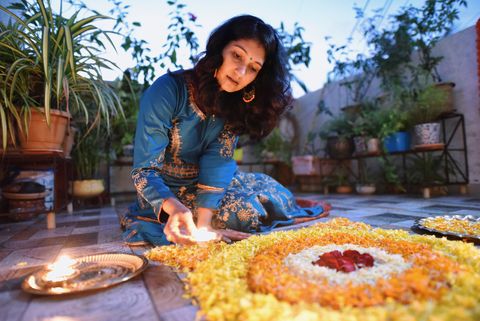For people of Indian descent across that country and the world, Diwali is one of the most widely celebrated festivals, according to The Hindu American Foundation. The festival, whose name comes from the Sanskrit word dipavali, meaning “row of lights,” serves as a beacon of brightness every year, celebrating the victory of light over darkness, good over evil and knowledge over ignorance. It’s a time to gather with friends and family and bask in the light of each other’s company, while preparing for a fruitful year ahead.
Just like so many other cultural and religious holidays, people mark Diwali (sometimes also spelled Divali) in different ways across the culturally diverse regions of India and throughout the global diaspora. Celebrated by people of Hindu, Buddhist, Jain and Sikh traditions, as well as those of Indian and non-Indian descent, the festival lasts for five days, starting on the 13th day of the dark half of the lunar month Ashvina to the second day of the light half of the lunar month Karttika. This year, the third day of Diwali, often the most prominent celebration, falls on Nov. 4, 2021.
What is Diwali?
Diwali typically commemorates the return of Prince Rama of Ayodhya, his wife Sita, and brother Lakshman after 14 years of exile, The Hindu American Foundation explains. In the Hindu tradition, Prince Rama is seen as an incarnation of Lord Vishnu and an embodiment of dharma or righteousness. Sita is an incarnation of Lakshmi, the goddess of wealth and prosperity. The residents of Ayodhya were so glad the rightful king and queen had returned, they lit lamps in their honor, an element of the festivities that’s still an important part of the festivities today.
Other traditions recognize Diwali as the day Lord Krishna defeated the demon king Narakasura and for some regions of India, it also coincides with the Hindu New Year. But many people celebrate more generally as a time to gather with friends and family, feasting and looking forward to the year ahead.
“I’ve always known that Diwali was the Festival of Lights and a major holiday for many South Asians, but I didn’t really understand the origins of the holiday and how diversely it’s celebrated across cultures, religions and regions until I started researching it,” explains Sonya Lalli, author of A Holly Jolly Diwali. “Diwali can mean so many things to so many people, but at its core, for me it’s about celebrating the light in this world over the darkness, being with the people I love.”
What happens during Diwali?
Because it’s celebrated by a diverse range of people with their own faith backgrounds and cultural traditions, many people celebrate the holiday in their own unique ways, but it’s generally a time for family, performing acts of dana (charitable giving) and seva (selfless service), deep cleaning and decorating the home, performing religious ceremonies, stringing up lights and reflecting on deeply-held values. The festivities can span over five days, each of them holding its own significance:
- Dhanteras: The first day is dedicated to the goddess Lakshmi, and people often mark the occasion by cleaning their houses and making rangolis or kolam, intricate colored patterns made on the floor with flowers, powder, rice or sand. They often go shopping, and make sweet and savory Indian treats to share.
- Chhoti Diwali or Kalichaudas: The second day, also known as “small Diwali” is often spent preparing for the largest celebration that takes place on the third day. People also offer prayers for the souls of their departed ancestors and many display clay lamps, called diya.
- Diwali: The third and largest day of the five days of Diwali involves dressing in new clothes, visiting a temple to perform a puja, or worship service, lighting diyas and other lights around the house, and enjoying fireworks celebrations. It’s a time for gathering with loved ones, feasting and playing games of chance, especially card games.
- Annakut, Padwa, Govardhan Puja: The fourth day of Diwali marks the first day of the New Year for many regions of India, a time to feel thankful for the past year, look ahead to the next and exchange small gifts. Some people perform pujas for a prosperous new year. This day can also be dedicated to the bond between husbands and wives, to recognize the love between Rama and Sita.
- Bhai Duj, Bhai Bheej: The fifth and final day of Diwali celebrates the bond between sisters and brothers, so family members will often visit one another on this day and share a meal together.
How do people celebrate?
Diwali celebrations frequently include small gifts, like jewelry, mementos, items for the home or those that hold special meaning, explains Shereen Bhalla, PhD, director of education at the Hindu American Foundation. And just like many other holidays, food plays an important role too. “In particular, it is common to see Besan Ladoos given out – these are made out of chickpea, ghee, palm sugar and cardamom,” she adds, noting that specific dishes (and gifts, for that matter) vary depending on the region and people celebrating.
For Lalli, Diwali has always meant appreciating each other’s company, regardless of what activities happen while they’re together. “My parents are from different faiths, have different mother tongues, and hail from different parts of India, and growing up we celebrated Diwali and other holidays in an open and relaxed way, often forgoing specific cultural traditions in favor of hanging out, eating and spending time together,” she explains. “But one thing we always did was light several diya or small candles, offer our prayers and take a few moments to appreciate all that we have been given in this world.”
This content is created and maintained by a third party, and imported onto this page to help users provide their email addresses. You may be able to find more information about this and similar content at piano.io


